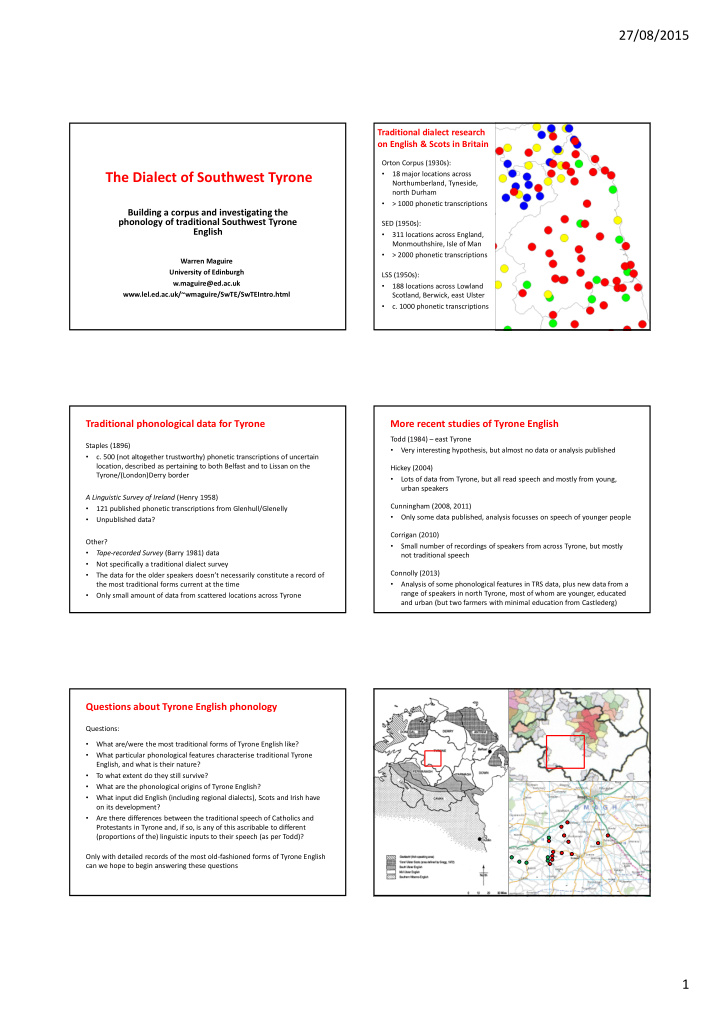



27/08/2015 Traditional dialect research on English & Scots in Britain Orton Corpus (1930s): The Dialect of Southwest Tyrone 18 major locations across • Northumberland, Tyneside, north Durham > 1000 phonetic transcriptions • Building a corpus and investigating the phonology of traditional Southwest Tyrone SED (1950s): English 311 locations across England, • Monmouthshire, Isle of Man > 2000 phonetic transcriptions • Warren Maguire University of Edinburgh LSS (1950s): w.maguire@ed.ac.uk 188 locations across Lowland • www.lel.ed.ac.uk/~wmaguire/SwTE/SwTEIntro.html Scotland, Berwick, east Ulster c. 1000 phonetic transcriptions • Traditional phonological data for Tyrone More recent studies of Tyrone English Todd (1984) – east Tyrone Staples (1896) Very interesting hypothesis, but almost no data or analysis published • c. 500 (not altogether trustworthy) phonetic transcriptions of uncertain • location, described as pertaining to both Belfast and to Lissan on the Hickey (2004) Tyrone/(London)Derry border Lots of data from Tyrone, but all read speech and mostly from young, • urban speakers A Linguistic Survey of Ireland (Henry 1958) Cunningham (2008, 2011) 121 published phonetic transcriptions from Glenhull/Glenelly • Only some data published, analysis focusses on speech of younger people Unpublished data? • • Corrigan (2010) Other? Small number of recordings of speakers from across Tyrone, but mostly • Tape-recorded Survey (Barry 1981) data • not traditional speech Not specifically a traditional dialect survey • Connolly (2013) The data for the older speakers doesn’t necessarily constitute a record of • Analysis of some phonological features in TRS data, plus new data from a the most traditional forms current at the time • range of speakers in north Tyrone, most of whom are younger, educated Only small amount of data from scattered locations across Tyrone • and urban (but two farmers with minimal education from Castlederg) Questions about Tyrone English phonology Questions: What are/were the most traditional forms of Tyrone English like? • What particular phonological features characterise traditional Tyrone • English, and what is their nature? To what extent do they still survive? • What are the phonological origins of Tyrone English? • What input did English (including regional dialects), Scots and Irish have • on its development? Are there differences between the traditional speech of Catholics and • Protestants in Tyrone and, if so, is any of this ascribable to different (proportions of the) linguistic inputs to their speech (as per Todd)? Only with detailed records of the most old-fashioned forms of Tyrone English can we hope to begin answering these questions 1
27/08/2015 Speaker Occupation Speaker Occupation SwTE corpus – 28.5 hrs of audio recordings (so far) PM00 †farmer PM42* farmer Legacy recordings from the late 1980s and early 1990s of a number of old • PF14 †housewife PM43 farmer, salesman speakers in the community born in the early 20th century (2 hrs 50 mins) PF19 †farmer, housewife CM44 farmer, labourer One-to-one interviews (typically involving discussion of local life and • PM23* †farmer PM45 unemployed history, farming practices, and superstitions) with 17 current residents of the area born in the early and mid 20th century, made between 2003 and PM24 †farmer CM47 farmer, digger-man 2015 (18 hrs 45 mins) PM26* †farmer PF49 office worker Answers to the Survey of English Dialects questionnaire by two speakers • PM29 farmer PF50 caterer (CM39 and PM43, neighbours), made between 2004 and 2015 (5 hrs 30 mins) PM38* farmer PM50 farmer, postman Range of wordlist and reading tasks designed to investigate various • CM39* farmer PM54* farmer aspects of the phonology of the dialect, especially the MEAT-MATE (near-) merger (1 hr 25 mins) PF40* domestic worker PM55* unemployed PF41* farmer PM75* farmer Examples Features currently under investigation See transcriptions on the handout Pre-R Dentalisation (English, Scots, ?Irish) PM00 Epenthesis in liquid + nasal clusters (English, Scots, Irish) Remembering news of the hanging of Joe Moan, the ‘Trillick Murderer’, in film [ˈfələm], farm [ˈfaɹəm] • • 1904 Velar palatalisation (English, Irish, ?Scots) CM39 car [cäːɹ], cat [cat], get [ɟɛt], give [ɟəv] (cf. calm [käːm], calf [käːv]) • Talking about threshing and wapping straw • Palatal velarisation (Irish, ?Scots) PM43 Christian [ˈkɹəscən], furniture [ˈfɔ̈ɹnəcəɹ], idiot [ˈiɡət]/[ˈiɟət], Indian • Answering SED questions IV.4.1, IV.4.2, IV.4.4 ( lice/louse , nits , fleas ) [ˈɛ̈ɲɟən], question [ˈkwɛscən]/[ˈkwɛskən], stupid [ˈscʉpət] • PF50 The MEAT lexical set (and its relationship with MATE) MEAT-MATE minimal pairs • The MEAT lexical set MEAT-like pronunciations of MEAT 100.00 The MEAT lexical set has well known (again stereotyped) MATE-like pronunciations in Irish English (including SwTE) e.g. beak, beat, cheap, concrete, decent, easy, eat, flea, Jesus, meat, peas, • 80.00 speak, tea, teacher, weak % MATE-like MEAT Milroy and Harris (1980) and Harris (1985) showed that in Belfast Vernacular 60.00 English MEAT and MATE are in a situation of near merger they are pronounced almost the same, with near-complete overlap in • realisation, but their pronunciations are statistically different 40.00 [ɪə] preferred in MATE, [e] in MEAT • BUT: Milroy and Harris’s study was based on a small number of tokens, not 20.00 analysed acoustically The SwTE corpus affords us an excellent opportunity to investigate the MEAT 0.00 PM00 PF14 PF19 PM23 PM24 PM26 PM29 PM38 CM39 PF40 PF41 PM42 PM43 CM44 PM45 CM47 PF49 PF50 PM50 PM54 PM55 PM75 vowel in a Mid-Ulster English dialect in much more detail, since the feature survives well in the speech of traditional SwTE speakers Speaker 2
Recommend
More recommend